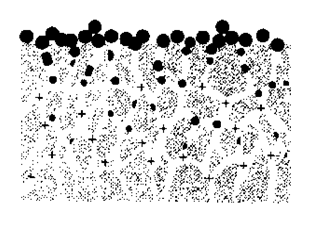What is depth filtration?
Depth filtration utilizes the thickness (depth) of a cellulose based filter media. This “depth” matrix is used to trap suspended particles; separating them from their carrying fluid. Depth filtration is most commonly applied in polishing filtration applications including, but not limited to:
- Essential oil and extract clarification
- Haze removal in distilled spirits
- Blood fractionation operations recovering plasma
- Transformer oil filtration and water removal
- Bulk chemical production
- Large Volume Parenteral Solutions
The characteristic of depth filter media allow for fine filtrate removal with the flexibility to develop large filter cakes if needed. Depth filtration clarifies through several means of retention including sieving, interception, adsorption, and absorption.
Sieving occurs when the particulate is larger than the pore spaces in the media, and therefore cannot pass through.
Interception of solids occurs in depth media due to loss of energy. Solids must pass through a tortuous path while crossing the depth of the filter media. The loss of energy experienced traps solids within the matrix.
Adsorption is the adhesion of molecules to the solid structure that they are in contact with. Adsorption usually occurs as a result of physical attraction between molecules (van der Waals force), chemical attraction at the surface/molecule interface, or more commonly in depth media through electro-static attraction.
ErtelAlsop depth media is manufactured with varying amounts of wet strength resin mixed with cellulose fibers, the presence of these resins creates an inherent positive charge in our depth media filters. This positive charge (referred to as Zeta potential) generates an electro-static attraction (adsorption!) to negatively charged contaminants in the slurry stream.
Absorption characteristics within Depth Media helps to assist in the separation of water from oil based slurries. ErtelAlsop’s depth media is manufactured from cellulose fibers which naturally absorbs water through a blotter effect. For the most efficient water removal try ErtelAlsop’s patented AquaKV Paks which utilize a laminate and depth media combination and boasts a minimum water capture of 8oz per square foot
One major advantage of Depth Media is the ability to impregnate the medium with filter aids to assist in filtration and resist blinding. Commonly Depth Media is impregnated with Diatomaceous Earth (DE), Volcanic Ash (Perlite), and Activated Carbon. The addition of filter aids offers the following additional advantages
- Advantages of DE vs. Perlite
- Haze Filtration
- Retention Levels
- High Purity Grades
- Void Volume
- Advantages of Perlite vs. DE
- Low Crystalline Silica Content
- Wet Strength
For more information about how Depth Media can work for your process click here to Contact us today!




